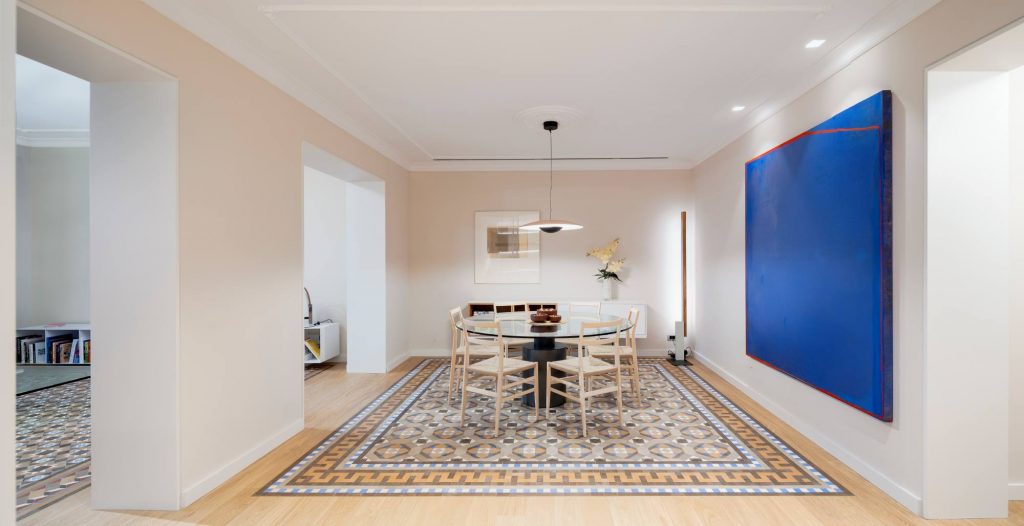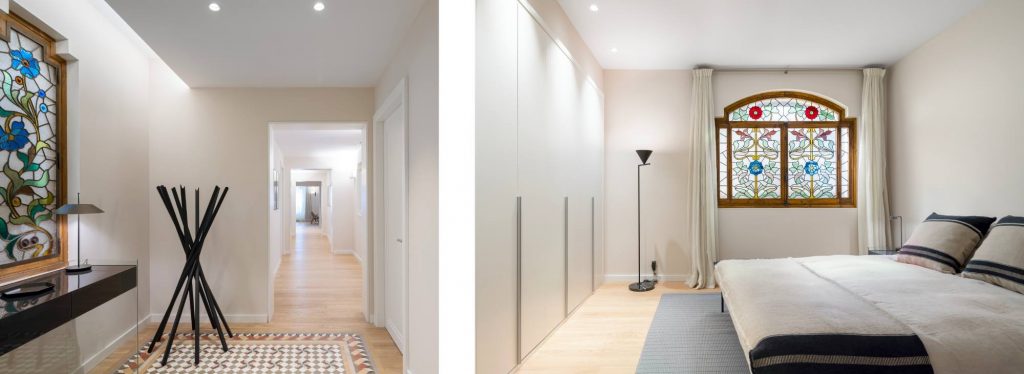What was GCA’s main vision when approaching the rehabilitation of Casa Condeminas?
Awareness and respect, with a clear goal of evolving the building towards modernity. The location, history, and current moment are concepts that define Casa Condeminas and its future.
Situated facing the sea, which inspired its creation, and near Barcelona’s historic center, it stands as a tribute to the city’s history and architecture. Built over 175 years ago and framed within the Modernist movement that would define its style, it is a work distinguished by its sophistication, its appreciation for decorative arts, and its design.
Its rehabilitation, in line with today’s standards, required the integration of modernity in its design, functionality, and efficiency. However, we always knew that it was a concept we had to incorporate consciously, respecting the place and its history. We had to honor its origins during the rehabilitation while preserving and integrating original elements with new concepts and properly adapting the spaces for their new use.
What was the most challenging aspect of renovating a building with such historical significance?
One of the most significant challenges in this project was adapting it to current regulations without altering the original composition of the building.

Integration could be the key word applied to each of its disciplines. To rehabilitate the various elements, it was necessary to delve into the past, understand the intention of that time, and reinterpret and transform it from there. Each space is unique, and the approach was to understand the whole and establish a set of parameters that would allow the transition and dialogue between the different spaces.
As a listed building, it required more complex conditions than a conventional one. We had to respond to Barcelona’s Department of Heritage, acknowledging the building’s history while complying with current regulations to achieve a result that met all requirements. To do so, we had to abandon conventional construction details and design new solutions to address the previous points.
How do you harmonize modern comforts with the building’s historical architecture?
With great care. The GCA Architects team worked for more than nine years alongside a large team of rehabilitation specialists and expert artisans in various crafts, some of whom were the third generation of the original creators. This allowed us to guarantee the quality of the execution by maintaining the same techniques and quality processes as at its origin. At the Condeminas building, the focus was not on speed but on the quality of the recovery and craftsmanship.
The original environmental context was respected as a premise, with various elements integrated discreetly to achieve the necessary comfort without altering their function. Location, colors, shapes, etc., were some of the resources used to make certain elements blend in.
One of the key points in the design development was the full integration of the spaces, both among themselves and with the elements that form them. The goal was to achieve a duality that would complement both the unique characteristics of the environment and the needs and technologies of the present.

Casa Condeminas stands at a key point in the city. Could you share a personal anecdote related to Barcelona’s Gothic Quarter?
One day, while visiting the Condeminas House, I hadn’t walked through the Gothic Quarter in a while, and as it was somewhat on my way between site visits, I felt like wandering through it to find a place to stop for lunch.
While walking, I turned a corner and, to my surprise, found a small square I didn’t remember, surrounded by old buildings with façades full of history and wrought-iron balconies.
Then, an elderly woman, around 80 years old (I didn’t see where she came from), approached me smiling and asked in perfect Catalan if I was an architect, surprising me greatly since at that moment I wasn’t carrying anything that would identify me as such.
Taken aback, I looked at her for a few moments without replying, and she quickly added, saying she knew it by the way I was looking at the buildings. She told me her father had been an architect, and they had lived in that square all their lives. It was a heartwarming moment.

If you could collaborate with a famous architect, who would it be and why?
If I had the opportunity, I would choose three: Ludwig Mies van der Rohe, Richard Neutra, and Frank Lloyd Wright.
Each of them left an indelible mark on the world of design and construction. In all three, we would find a combination of simplicity and functionality, a relationship with the natural environment, and the creation of organic, holistic architecture.
These are shared principles and an approach to architecture that I identify with and endorse.
What is your favorite place in Barcelona to disconnect and seek inspiration when you’re not working?
I am fortunate to live in a city rich in architecture, culture, and history. In addition to its heritage and its cosmopolitan cultural life, blending many influences, it is very close to natural settings that contrast completely with urban life—the sea and the mountains are just a step away. Simply put, it’s a privilege that I greatly value.
I don’t have a favorite place to find inspiration in Barcelona or its surroundings. Inspiration almost finds you—it’s more about finding a moment of calm, paying attention to the details, and having an open mind to appreciate how all the elements and influences around you reveal themselves.

What is your best-kept secret to enjoying the city like a local?
First, it’s essential to understand the importance of the neighborhood in Barcelonan life. Each district has its own character and charm. Gràcia, for example, retains a bohemian air with its squares and narrow streets, perfect for wandering aimlessly.
Here, small local designer shops and family-run tapas bars offer a cozy experience. The Mercat de la Llibertat, less known than La Boqueria, is an ideal spot to discover local flavors and chat with vendors about proximity products.
Immerse yourself in the local rhythm of life. Adopt the habit of “vermut” on a sunny terrace, perhaps in one of those bars that make their own. That’s where the true essence of Barcelona’s social life lies.
From a more creative or intellectual perspective, there’s no better way to get to know the city than through its art and architecture. Beyond Gaudí’s famous icons, Barcelona is full of lesser-known architectural gems, such as the Hospital de Sant Pau, with its evolving origins tied to historical milestones in medicine and the city’s growth and needs.
We also find contemporary art galleries like the Joan Miró Foundation or MACBA, connecting with both the local and global art scene in a more current framework. Second-hand bookstores, like La Central del Raval, are great places to discover unique literary gems and participate in talks and cultural events. The Ateneu Barcelonès, a centuries-old institution, offers a space for the exchange of ideas and participation in debates and conferences on various topics.
In short, for me, the secret to enjoying Barcelona like a local lies in a combination of conscious exploration, appreciation of art and architecture, and adopting local customs. Immerse yourself in the neighborhoods, connect with people, and let yourself be carried away by the rhythm of daily life.

A restaurant by the sea.
A seaside restaurant, Quesada, isn’t in Barcelona but in Gavá Mar. I’ve known it for about 40 years, and it still has its unique beach access, which makes it even more special—you literally have to take your shoes off in the sand to get there, and of course, its terrace is right on the beachfront. I have fond memories of great times spent in this place.
A book you can recommend.
 In Praise of Shadows by Jun’ichirō Tanizaki. It speaks of traditional Japanese aesthetics and contrasts Western and Eastern cultures. It offers a deep reflection on the subtle beauty of the imperfect and the ephemeral, highlighting how dim lighting and natural materials enhance the essence of spaces and objects, and how these elements play a fundamental role in Japan’s architecture, decoration, and daily life.
In Praise of Shadows by Jun’ichirō Tanizaki. It speaks of traditional Japanese aesthetics and contrasts Western and Eastern cultures. It offers a deep reflection on the subtle beauty of the imperfect and the ephemeral, highlighting how dim lighting and natural materials enhance the essence of spaces and objects, and how these elements play a fundamental role in Japan’s architecture, decoration, and daily life.
A city to discover.
From an architectural perspective, throughout history, Barcelona has experienced three key moments that have shaped its unique creative universe.
The first pivotal moment coincided with the flourishing of Mediterranean trade and an expanding empire. An immersion in the culture and history of the place reflects and celebrates the unique cultural spirit of this specific site. It was then, during the 13th century, that the current historic center filled with Gothic buildings was born. Later, at the end of the 19th century, Barcelona had its second great era with the demolition of the medieval walls and the urban expansion that brought about the Eixample.
It was a liberation of architecture that also opened the doors to the imagination of the Modernists. Finally, in 1986 and 1992, Barcelona capitalized on Spain’s entry into Europe and the organization of the Olympic Games to project itself to the world with a new image. The city set out to be the international benchmark for a new urban model.
The legacy of all these moments defines Barcelona today and the life lived in it daily. Barcelona’s architecture is a spectacle in itself—here, every corner tells a story, offering a unique combination of history, culture, architecture, and gastronomy.

Share